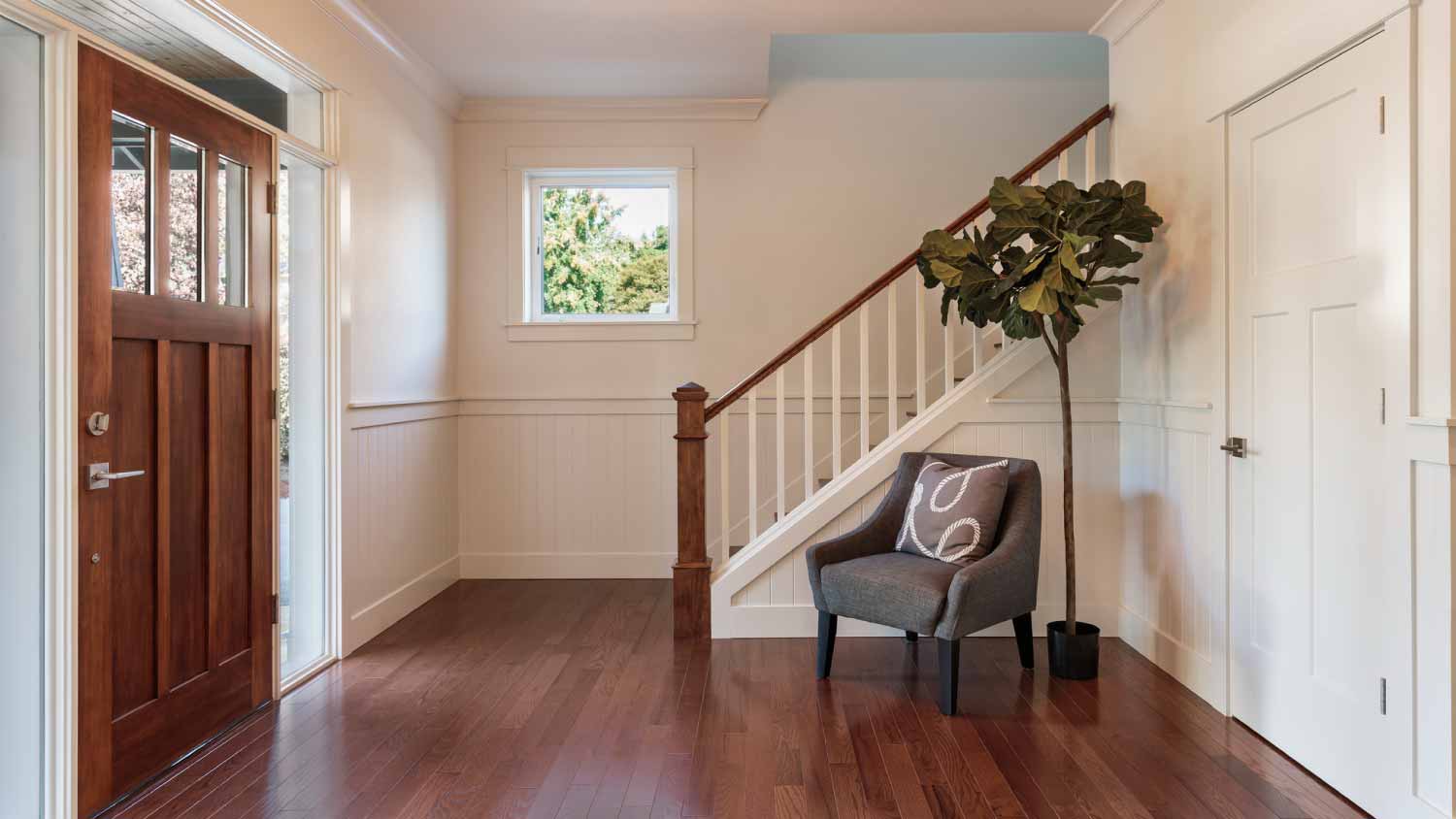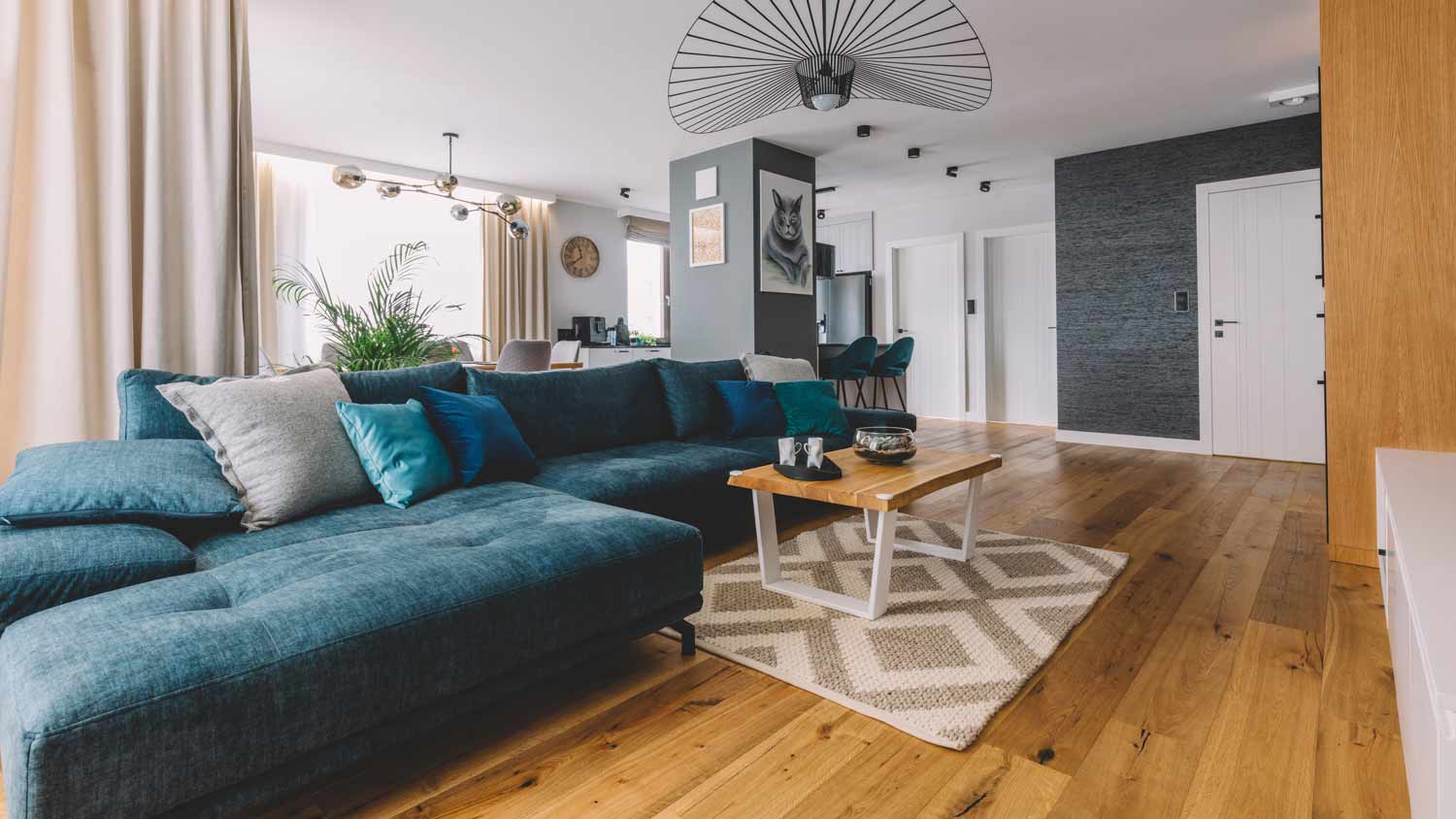How Much Does It Cost to Remove Laminate Flooring? [2025 Data]
Removing laminate flooring costs an average of $400, depending on the amount that needs to be removed, your location, and haul-away fees. A flooring pro can estimate your overall cost.


The cost to remove laminate flooring is typically between $200 and $1,000, or $2 to $3 per square foot. This material is often used as a cost-effective alternative for homeowners who like the look of hardwood—but not the price tag. Though it’s durable, it does not have the same longevity.
Even if you maintain your floors meticulously, there may be a time where you eventually need to remove it. Let’s weigh the costs, whether you’re looking for a replacement floor or an upgrade.
Laminate Floor Removal Cost Factors

The average cost to remove laminate flooring is around $2 to $3 per square foot, but certain factors will impact the final price tag.
Size of Area
The larger the area, the longer it will take to remove your flooring and the more it will cost. Since laminate flooring clicks and locks together, installing or removing planks is relatively simple for someone with experience—especially if you don’t need to remove the subfloor.
For this reason, contractors may charge a day rate of around $200 to remove laminate in a small area. That said, it can take a full day of work to remove a large area of flooring. A standard 200-square-foot floor costs $400 to $600 to remove.
| Room | Average Laminate Flooring Removal Cost |
|---|---|
| Small kitchen | $200–$600 |
| Large kitchen | $480–$900 |
| Small bedroom | $400–$600 |
| Primary bedroom | $600–$900 |
| Living room | $680–$1,020 |
Labor
Labor is the most significant laminate floor repair cost. Most flooring contractors charge $25 to $35 per hour, though floor removal is usually wrapped into a larger project like a floor replacement.
It’s not just about disposing of your old floors. Contractors will move furniture and remove baseboards, molding, and thresholds. They’ll also reinstall those elements and clean up the area when they’re finished.
Location
You can expect to spend more to remove laminate flooring in an area with a high cost of living. For example, a contractor in New York may charge up to $120 per hour, whereas a contractor in Charlotte, North Carolina may charge $30 per hour.
Disposal or Haul-Away Fees
Disposal is most likely an additional fee. Your contractor will need to haul away the debris when they’re finished. Expect to spend $150 to $400. If you’re demolishing an entire room, a small residential dumpster rental costs $100 to $300 per week.
Common Add-Ons
Floor removal isn’t typically a stand-alone project. It’s usually part of a larger remodel or replacement—and it can incur some additional costs.
| Laminate Flooring Removal Add-Ons | Average Cost (Per Square Foot) |
|---|---|
| Water damage remediation | $3–$11 |
| Mold removal | $10–$25 |
| New flooring installation | $2–$22 |
| Asbestos remediation | $5–$20 |
Water Damage Remediation
Laminate repair from water damage can cost anywhere from $400 to $2,200 or $3 to $11 per square foot. The size of the damaged area and the depth of the damage significantly affect the repair costs. For example, if there’s subfloor damage, the costs will be higher than if the damage is limited to the laminate.
In some cases, laminate can be replaced in sections, like specific tiles or planks, which keeps costs low. In other circumstances, the damage may be so extensive that most laminate must be removed and replaced.
Mold Removal
On average, mold testing costs $250 to $300, and mold remediation costs $10 to $25 per square foot. Mold is common in water-damaged laminate flooring. Floating laminate floors are not glued or nailed down to the subfloor. Rather, the planks snap into place above the subfloor, which leaves room for moisture to settle in the space between.
New Flooring Installation
Most homeowners remove laminate flooring because they’re replacing their floors. On average, new flooring installation costs $2 to $22 per square foot, depending on the type of floor. Most homeowners end up spending $1,500 to $4,500 for a 500-square-foot room. The cost to install new laminate flooring averages about $3,000.
Asbestos Remediation
Old laminate flooring—particularly glued-down tiles—can contain asbestos. If your home was built before 1980, you may want to have your flooring tested before you remove it. An asbestos test costs $230 to $800, while asbestos remediation costs $5 to $20 per square foot.
Cost to Remove Laminate Flooring Yourself vs. Hiring a Pro
Handy homeowners can remove a laminate floor in an afternoon (or a weekend if it’s a larger space). Most of the cost to remove laminate flooring is labor, so you can save hundreds by doing the work yourself. You can pull up the planks using a pry bar, with help from a utility knife and pliers. You’ll also need a hammer and a screwdriver to remove the trim. You’ll most likely need to rent a dumpster, which can be the largest expense when DIYing this project.
That said, demolition is only a good idea if you know what you’re doing. Pipes and electrical wires can hide beneath flooring, and damaging them could cause injury or lead to expensive repairs.
It’s also important to have a professional evaluate the integrity of your flooring if you’ve experienced significant water damage that could have caused structural issues. Since most contractors wrap floor removal into the cost of installing a new floor, it’s often easier to call a flooring company near you.
4 Reasons You Should Remove Your Laminate Flooring
You can’t refinish laminate like you’d refinish hardwood floors. Though homeowners can swap out damaged laminate planks, you may need to replace your floor if it requires more extensive repairs. That said, there are a wealth of reasons you might want to get rid of your laminate flooring.
Water Damage
Laminate flooring is vulnerable to water. Though it can withstand a spill that’s quickly mopped up, planks can bubble and warp when the water starts to penetrate the surface. Water can also seep below the gaps between planks, damage the subfloor, and harbor mold.
Most often, the only way to fix a water-damaged laminate floor is to replace any affected planks and subflooring.
Improper Installation
If the previous homeowner incorrectly installed laminate flooring, you may have to replace your floor to fix the issue. Signs of a poor installation include:
Large gaps between planks
Buckling planks
Planks with lifted corners or frayed edges
Uneven or loose planks
Soft spots
Unlevel floor
Excessively creaky floor
Health Concerns
Laminate flooring, especially the kind that uses adhesive, can off-gas voluntary organic compounds (VOCs). One of the most prevalent is formaldehyde, but it depends on the specific product.
According to the Centers for Disease Control and Prevention (CDC), formaldehyde exposure can cause irritation and breathing problems (especially for children, older adults, and people with asthma). It’s also linked to an increased risk of cancer. The good news is that VOC levels do taper off over time, and it’s more of a concern when the product is new.
Because of the potential health effects, some homeowners choose to remove their laminate flooring and install linoleum flooring or hardwood.
Home Remodel
If you have the budget, wanting a new floor with a different look is enough of a reason to remove your existing laminate. Many homeowners replace their flooring during a home remodel—and you can even save money on the demolition if you’re demoing multiple rooms at once.
How Angi Gets Its Cost Data
Home is the most important place on earth, which is why Angi has helped more than 150 million homeowners transform their houses into homes they adore. To help homeowners with their next project, Angi provides readers with the most accurate cost data and upholds strict editorial standards. We extensively research project costs to develop the pricing data you see, so you can make the best decisions for you and your home. We rely on reputable sources, including the U.S. Bureau of Labor Statistics, academic journals, market studies, and interviews with industry experts—all to ensure our prices reflect real-world projects.
Want to help us improve our cost data? Send us a recent project quote to costquotes@angi.com. Quotes and personal information will not be shared publicly.
Frequently Asked Questions
Removing laminate flooring is fairly straightforward compared to removing other types of flooring. The planks click and lock into place, so you can pry them loose without much fuss. If you plan to reuse your flooring, you must be careful not to damage the plank or the locking mechanism that keeps it in place. If it’s in good condition, you can reuse it in another room.
Most laminate floors are floating laminate, which locks into place above the subfloor. You’ll need to use a pry bar (preferably with a straightedge and a claw at opposite ends) to pry up the planks. You’ll also need a utility knife, a drywall knife, and pliers. If your laminate floors are glued into place, use an orbital sander and floor scraper to get rid of the glue.
You can remove glued-down laminate floor by prying up each individual tile with a pry bar, then scraping off the glue with a scraper. A heat gun can help soften the glue and make it easier to peel away. Keep in mind that old laminate floor tiles may contain asbestos, particularly in the adhesive. If your home was built before the 1980s, consult a pro.
Whether it’s more inexpensive to install carpet or laminate flooring depends on the specific material since luxury carpeting can get pricey. Carpeting costs $3.50 to $11 per square foot, while laminate costs $3 to $10 per square foot.
Though the two materials are close in price, the average homeowner does save a few hundred on carpet. The cost to replace carpet with laminate is $2,870, while carpet installation costs about $2,200, including floor removal.

.jpg?impolicy=leadImage)













